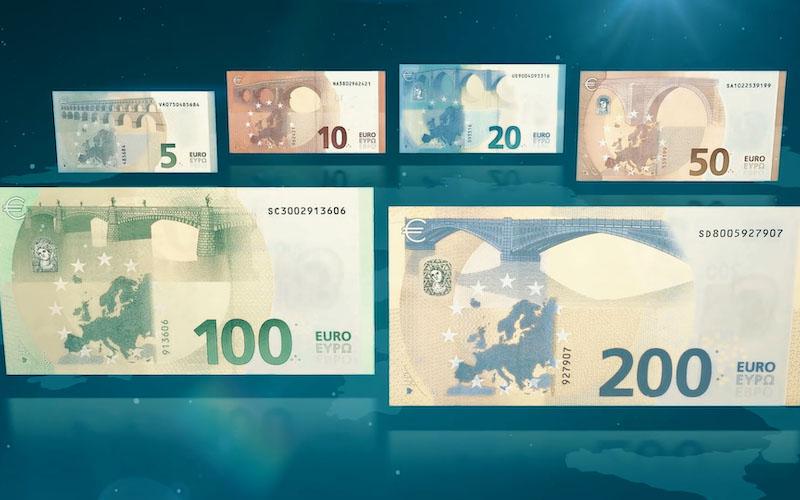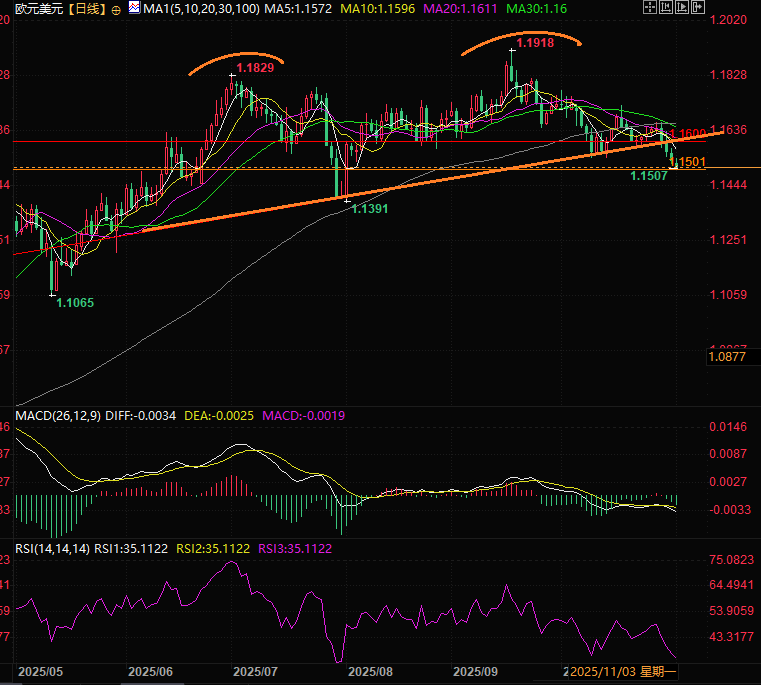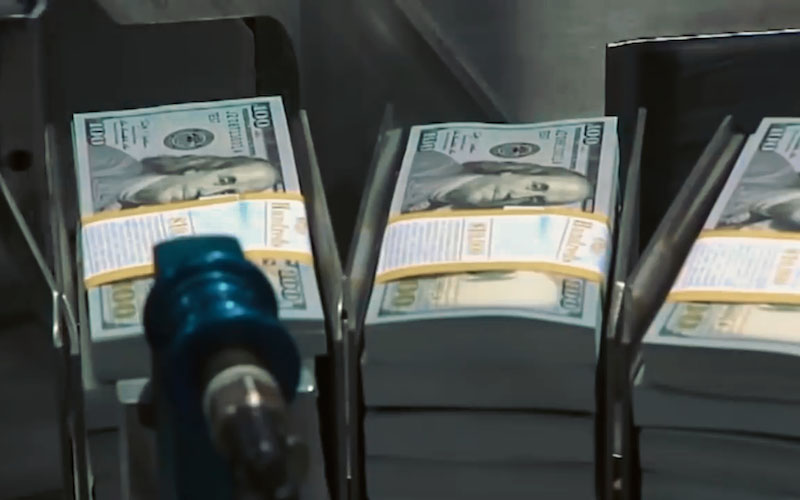The Euro has broken down across the board technically, becoming the eye of the storm! The bears are pressing in, and the 1.15 level is about to face its ultimate test.
2025-11-03 18:28:51
The euro hovered near a three-month low against the dollar amid a strengthening dollar. Over the past three trading days, the pair has fallen nearly 1%, influenced by the dollar's rise driven by the Federal Reserve's hawkish stance. On Monday, Eurozone manufacturing data was slightly better than expected overall, but this did not reverse the euro's downward trend.
During the Asian and European trading sessions, major currency pairs saw relatively calm fluctuations, as market liquidity was limited due to a Japanese bank holiday, leading to a decrease in volatility.
In Europe, Bundesbank President and ECB Monetary Policy Committee member Joachim Nagel pointed out on Monday that current economic data is not deviating from the ECB's expectations, but all policy options will remain open at the next meeting.

Market attention is focused on two key data points: the final reading of the Eurozone's October Manufacturing Purchasing Managers' Index (PMI) and the US Institute for Supply Management (ISM) Manufacturing PMI, which will be released later that day.
In addition, European Central Bank Governing Council member Philip Lane is expected to hold a press conference during the European trading session; during the US trading session, Federal Reserve officials Mary Daly and Lisa Cook may further explain the Fed's monetary policy plans.
European PMI slightly exceeded expectations, but could not mask overall weakness.
The key focus today is the final reading of the Eurozone's October Manufacturing PMI. The market expected the data to show that manufacturing activity rebounded from 49.8 in September to 50.0, the threshold between expansion and contraction. The data was released in line with expectations, with the Eurozone PMI reading being 50.
Meanwhile, Germany's manufacturing PMI was in line with expectations at 49.6, just below 50. The UK and France exceeded market expectations, with France at 48.8 (expected 48.3) and the UK at 49.7 (expected 49.6). Although they exceeded expectations, both were below the 50-point threshold separating expansion from contraction.
Although no worse-than-expected scenario occurred, the overall European PMI remained below the 50-point mark, failing to provide much optimism to the market, and the euro continued to decline against the dollar.
Euro bulls lack confidence, and ECB speeches are unlikely to provide a boost.
"The three-month implied volatility of the euro against the US dollar continues to decline and has now fallen below 6%. There are currently no clear factors that can prevent it from falling further to the low of 5.30% in the summer of 2024."
Meanwhile, the three-month risk reversal indicator for euro/dollar has fallen back to flat level (in May, this indicator showed a 1% premium for euro/dollar call options), a signal that euro/dollar bulls have basically given up confidence in holding their positions.
The market generally expects the euro to rise to 1.18 against the dollar by the end of the year. We believe that if the Federal Reserve releases dovish signals, the euro's rise against the dollar may slightly exceed this expectation, but such views are currently being suppressed by market sentiment.
"The dollar's performance is expected to continue to dominate the euro-dollar exchange rate fluctuations this week."
However, several European Central Bank (ECB) officials will speak this week in the Eurozone, with the first speech scheduled for 8:00 PM CET today by Chief Economist Philip Lane. But judging from the current tone, the ECB's comments are expected to have limited support for the euro against the dollar; current policy discussions are focused more on whether Eurozone inflation is lower than expected and whether the ECB needs to further cut interest rates.
Hawkish Fed + policy uncertainty eliminated, short-term support solidified.
Early Thursday morning last week, Federal Reserve Chairman Jerome Powell delivered hawkish remarks, forcing investors to lower their expectations for further monetary easing this year. This shift suppressed market risk appetite and pushed the dollar higher for three consecutive trading days last week.
According to the CME FedWatch Tool, the market's probability of a 25-basis-point rate cut by the Federal Reserve in December has fallen from over 90% before the Fed meeting to 67% on Monday.

(CME FedWatch Interest Rate Futures Chart)
Traders are currently reluctant to short the dollar primarily due to the lack of compelling negative news from the US. The ongoing US government shutdown means that key employment market data needed for the Federal Reserve's December interest rate decision remains unavailable.
Nevertheless, given the impact of the data release gap, the potential for further dollar rebound remains to be seen.
The US dollar remained stable near its recent highs, with investors still preferring to control their risk exposure and unwilling to take on too much uncertainty.
In the US market, with the government shutdown now in its fifth week and the lack of official economic data, private sector data has become the core basis for assessing macroeconomic fundamentals. Therefore, the Institute for Supply Management (ISM) Manufacturing PMI holds particular significance. The market expects the October ISM Manufacturing PMI to rise slightly to 49.2 from 49.1 in September, with the "Prices Paid" sub-index expected to rise from 61.9 to 62.6. This expectation further confirms that inflationary pressures stemming from rising tariffs persist.
Euro/Dollar Outlook: ECB in Favorable Policy Range
Last week, despite the Eurozone releasing better-than-expected GDP data and the European Central Bank signaling that it was "currently in a favorable policy range," the euro still fell against the dollar due to the strengthening of the dollar.
European Central Bank President Christine Lagarde said at a press conference last week: "From a monetary policy perspective, we are currently in a favorable position."
"Is this advantageous position fixed? The answer is no, but we will take all necessary measures to ensure that we remain in this range."
The above remarks send a clear signal: unless there are significant changes in subsequent data, the European Central Bank has essentially ended its rate-cutting cycle, and this policy stance is expected to provide a floor for the euro-dollar exchange rate.
Technical Analysis:
As can be seen from the daily chart of the euro against the US dollar, the euro has now changed from a sideways trend to a downtrend, as the exchange rate has broken below the key level of 1.1600, and the rate of decline has accelerated after the break.
The 5, 10, 20 and 30-day moving averages are all in a bearish alignment, and the neckline of what appears to be a complex head and shoulders pattern has been broken. The nearest support is around 1.1501, and the next support is further away at 1.1391.
For the euro to rebound, it may need to transition from a downtrend to a sideways consolidation, waiting for the moving averages to converge. As a result, the US dollar index may have a chance to reach the 100-point mark.

(Euro/USD daily chart, source: FX678)
At 16:23 Beijing time, the euro was trading at 1.1514/13 against the US dollar.
- Risk Warning and Disclaimer
- The market involves risk, and trading may not be suitable for all investors. This article is for reference only and does not constitute personal investment advice, nor does it take into account certain users’ specific investment objectives, financial situation, or other needs. Any investment decisions made based on this information are at your own risk.





















